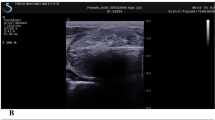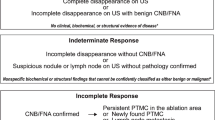Abstract
Objectives
To evaluate the 5-year follow-up results of radiofrequency ablation (RFA) for benign thyroid nodules (BTNs), and construct pre- and postablation nomogram models to predict regrowth in BTNs undergoing RFA.
Methods
According to the occurrence of regrowth, BTNs were divided into two subgroups, the regrowth group and the nonregrowth group, and the variables were compared between these two subgroups. Then, univariate and multivariate Cox regression analyzes were utilized to filter the independent prognostic factors of regrowth, which then were introduced into the pre- and postablation prognostic nomograms, respectively. The discrimination powers and prediction performances of the nomograms were appraised by receiver operating characteristic (ROC) curves and calibration charts.
Results
The 5-year mean volume reduction rate was 88.80%, with a complication rate of 0.35% (7/200). Within 5 years of follow-up, the regrowth rate was 19% (38/200). Pre- and postablation prognostic nomograms were established to predict the probability of nonregrowth at 1, 3, and 5 years after RFA. The preablation nomogram included initial volume, perinodular vascularity, and high enhancement ring. The postablation nomogram incorporated total volume, perinodular vascularity, and energy applied per volume. The area under the ROC curves and concordance index values of these models were all above 0.7, indicating that the prognostic nomograms achieved satisfactory discrimination powers and prediction performances.
Conclusion
RFA for BTNs has long-term efficacy and safety under the influence of key techniques. The pre- and postablation nomograms constructed in the present study might facilitate clinical decision-making before RFA and for the follow-up management after RFA.
Key Points
• Perinodular vascularity, rather than intranodular vascularity was an independent predictor of regrowth, both before and after the RFA procedure.
• A high enhancement ring on preablation contrast-enhanced ultrasound was an independent predictor of regrowth.
• Pre- and postablation nomograms might facilitate clinical decision-making before RFA and follow-up management after RFA.



Similar content being viewed by others
Abbreviations
- AUC:
-
Area under the curve
- BTNs:
-
Benign thyroid nodules
- CEUS:
-
Contrast-enhanced ultrasound
- EAV:
-
Energy applied per volume
- HER:
-
High enhancement ring
- IAR:
-
Initial ablation rate
- IPF:
-
Independent prognostic factor
- RFA:
-
Radiofrequency ablation
- ROC:
-
Receiver operating characteristic
- RVR:
-
Residual vital ratio
- US:
-
Ultrasound
- Va:
-
Ablation volume
- VRR:
-
Volume reduction rate
- Vt:
-
Total volume
- Vv:
-
Vital volume
References
Kim YS, Rhim H, Tae K, Park DW, Kim ST (2006) Radiofrequency ablation of benign cold thyroid nodules: initial clinical experience. Thyroid 16:361–367
Deandrea M, Limone P, Basso E et al (2008) US-guided percutaneous radiofrequency thermal ablation for the treatment of solid benign hyperfunctioning or compressive thyroid nodules. Ultrasound Med Biol 22:1436–1440
Sim JS, Baek JH (2021) Unresolved clinical issues in thermal ablation of benign thyroid nodules: regrowth at long-term follow-up. Korean J Radiol 22:1436–1440
Deandrea M, Trimboli P, Garino F et al (2019) Long-term efficacy of a single session of RFA for benign thyroid nodules: a longitudinal 5-year observational study. J Clin Endocrinol Metab 104:3751–3756
Bernardi S, Cavallaro M, Colombin G et al (2020) Initial ablation ratio predicts volume reduction and retreatment after 5 years from radiofrequency ablation of benign thyroid nodules. Front Endocrinol (Lausanne). https://doi.org/10.3389/fendo.2020.582550
Jiao ZY, Luo YK, Song Q, Yan L, Zhu YQ, Xie F (2020) Roles of contrast-enhanced ultrasonography in identifying volume change of benign thyroid nodule and optical time of secondary radiofrequency ablation. BMC Med Imaging. https://doi.org/10.1186/s12880-020-00476-1
Baek JH, Moon WJ, Kim YS, Lee JH, Le D (2009) Radiofrequency ablation for the treatment of autonomously functioning thyroid nodules. World J Surg 33:1971–1977
Baek JH, Moon WJ, Kim YS, Lee JH, Lee D (2019) Long-term outcomes following thermal ablation of benign thyroid nodules as an alternative to surgery: the importance of controlling regrowth. Endocrinol Metab (Seoul) 34:117–123
Sim JS, Baek JH, Lee J, Cho W, Jung SI (2017) Radiofrequency ablation of benign thyroid nodules: depicting early sign of regrowth by calculating vital volume. Int J Hyperthermia 33:905–910
Baek JH, Lee JH, Valcavi R, Pacella CM, Rhim H, Na DG (2011) Thermal ablation for benign thyroid nodules: radiofrequency and laser. Korean J Radiol 12:525–540
Park HS, Baek JH, Park AW, Chung SR, Choi YJ, Lee JH (2017) Thyroid radiofrequency ablation: updates on innovative devices and techniques. Korean J Radiol 18:615–623
Negro R, Greco G, Deandrea M, Rucco M, Trimboli P (2020) Twelve-month volume reduction ratio predicts regrowth and time to regrowth in thyroid nodules submitted to laser ablation: a 5-year follow-up retrospective study. Korean J Radiol 21:764–772
Sim JS (2021) Letter: twelve-month volume reduction ratio predicts regrowth and time to regrowth in thyroid nodules submitted to laser ablation: a 5-year follow-up retrospective study. Korean J Radiol 22:291–292
Sim JS, Baek JH, Cho W (2018) Initial ablation ratio: quantitative value predicting the therapeutic success of thyroid radiofrequency ablation. Thyroid 28:1443–1449
Yan L, Luo YK, Xie F, Zhang MB, Xiao J (2020) Residual vital ratio: predicting regrowth after radiofrequency ablation for benign thyroid nodules. Int J Hyperthermia 37:1139–1148
Bernardi S, Cavallar M, Colombin G et al (2021) Initial ablation ratio predicts volume reduction and retreatment after 5 years from radiofrequency ablation of benign thyroid nodules. Front Endocrinol (Lausanne). https://doi.org/10.3389/fendo.2020.582550
Ha EJ, Baek JH, Che Y et al (2021) Radiofrequency ablation of benign thyroid nodules: recommendations from the Asian Conference on Tumor Ablation Task Force. J Med Ultrasound 40:75–82
Papini E, Monpeyssen H, Frasoldati A, Hegedüs L (2020) 2020 European thyroid association clinical practice guideline for the use of image-guided ablation in benign thyroid nodules. Eur Thyroid J 9:172–185
Yan L, Luo YK, Xiao J, Lin L (2020) Non-enhanced ultrasound is not a satisfactory modality for measuring necrotic ablated volume after radiofrequency ablation of benign thyroid nodules: a comparison with contrast-enhanced ultrasound. Eur Radiol. https://doi.org/10.1007/s00330-020-07398-0
Mauri G, Pacella CM, Papini E et al (2019) Image-guided thyroid ablation: proposal for standardization of terminology and reporting criteria. Thyroid 29:611–618
Wang B, Han ZY, Yu J et al (2017) Factors related to recurrence of the benign non-functioning thyroid nodules after percutaneous microwave ablation. Int J Hyperthermia 33:459–464
Ha EJ, Baek JH, Kim KW et al (2015) Comparative efficacy of radiofrequency and laser ablation for the treatment of benign thyroid nodules: systematic review including traditional pooling and Bayesian network meta-analysis. J Clin Endocrinol Metab 100:1903–1911
Deandrea M, Garino F, Alberto M et al (2019) Radiofrequency ablation for benign thyroid nodules according to different ultrasound features: an Italian multicentre prospective study. Eur J Endocrinol 180:79–87
Wang B, Han ZY, Yu J, Liang P (2017) Factors associated with recurrence of BTN after ablation. Int J Hyperthermia 33:959–960
Zhao CK, Xu HX, Lu F et al (2017) Factors associated with initial incomplete ablation for benign thyroid nodules after radiofrequency ablation: first results of CEUS evaluation. Clin Hemorheol Microcirc 65:393–405
Sim JS, Baek JH (2021) Long-term outcomes of thermal ablation for benign thyroid nodules: the issue of regrowth. Int J Endocrinol. https://doi.org/10.1155/2021/9922509
Cheng Z, Liang P (2020) Advances in ultrasound-guided thermal ablation for symptomatic benign thyroid nodules. Adv Clin Exp Med 29:1123–1129
Schleder S, Janke M, Agha A et al (2015) Preoperative differentiation of thyroid adenomas and thyroid carcinomas using high resolution contrast-enhanced ultrasound (CEUS). Clin Hemorheol Microcirc 61:13–22
Radzina M, Ratniece M, Putrins DS, Saule L, Cantisani V (2021) Performance of contrast-enhanced ultrasound in thyroid nodules: review of current state and future perspectives. Cancers (Basel). https://doi.org/10.3390/cancers13215469
Zhang B, Jiang YX, Liu JB et al (2010) Utility of contrast-enhanced ultrasound for evaluation of thyroid nodules. Thyroid 20:51–57
Zhang Y, Luo YK, Zhang MB, Li J, Li JL, Tang J (2016) Diagnostic accuracy of contrast-enhanced ultrasound enhancement patterns for thyroid nodules. Med Sci Monit 22:4755–4764
Trimboli P, Deandrea M (2020) Treating thyroid nodules by radiofrequency: is the delivered energy correlated with the volume reduction rate? A pilot study. Endocrine 69:682–687
Jung SL, Baek JH, Lee JH et al (2018) Efficacy and safety of radiofrequency ablation for benign thyroid nodules: a prospective multicenter study. Korean J Radiol 19:167–174
Deandrea M, Trimboli P, Mormile A et al (2021) Determining an energy threshold for optimal volume reduction of benign thyroid nodules treated by radiofrequency ablation. Eur Radiol 31:5189–5197
Negro R, Rucco M, Creanza A et al (2020) Machine learning prediction of radiofrequency thermal ablation efficacy: a new option to optimize thyroid nodule selection. Eur Thyroid J 9:205–212
Balachandran VP, Gonen M, Smith JJ, DeMatteo RP (2015) Nomograms in oncology: more than meets the eye. Lancet Oncol 16:e173-180
Schiaffino S, Serpi F, Rossi D et al (2020) Reproducibility of ablated volume measurement is higher with contrast-enhanced ultrasound than with B-mode ultrasound after benign thyroid nodule radiofrequency ablation-a preliminary study. J Clin Med. https://doi.org/10.3390/jcm9051504
Yan L, Li XY, Xiao J et al (2022) Contrast-enhanced ultrasound is a reliable and reproducible assessment of necrotic ablated volume after radiofrequency ablation for benign thyroid nodules: a retrospective study. Int J Hyperthermia 39:40–47
Funding
The authors state that this work has not received any funding.
Author information
Authors and Affiliations
Corresponding authors
Ethics declarations
Guarantor
The scientific guarantor of this publication is Yukun Luo.
Conflict of interest
The authors declare no competing interests.
Statistics and biometry
No complex statistical methods were necessary for this paper.
Informed consent
Written informed consent was obtained from all subjects (patients) in this study.
Ethical approval
Institutional Review Board approval was obtained by the Institutional Review Board of People’s Liberation Army General Hospital (approval number: S2019-211–01).
Methodology
• retrospective
• diagnostic or prognostic study
• performed at one institution
Additional information
Publisher's note
Springer Nature remains neutral with regard to jurisdictional claims in published maps and institutional affiliations.
Rights and permissions
Springer Nature or its licensor (e.g. a society or other partner) holds exclusive rights to this article under a publishing agreement with the author(s) or other rightsholder(s); author self-archiving of the accepted manuscript version of this article is solely governed by the terms of such publishing agreement and applicable law.
About this article
Cite this article
Li, Y., Li, W., Jiang, B. et al. Analysis and prediction of regrowth in benign thyroid nodules undergoing radiofrequency ablation: a retrospective study with a 5-year follow-up. Eur Radiol 33, 5615–5624 (2023). https://doi.org/10.1007/s00330-023-09481-8
Received:
Revised:
Accepted:
Published:
Issue Date:
DOI: https://doi.org/10.1007/s00330-023-09481-8




